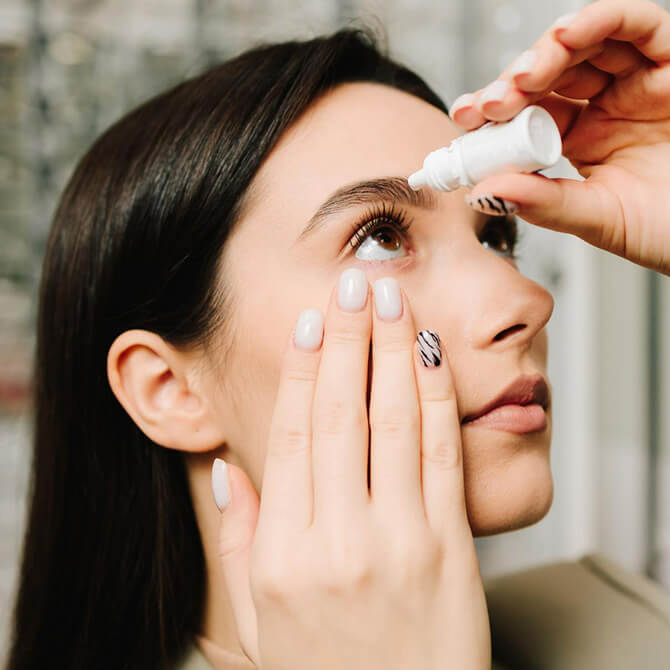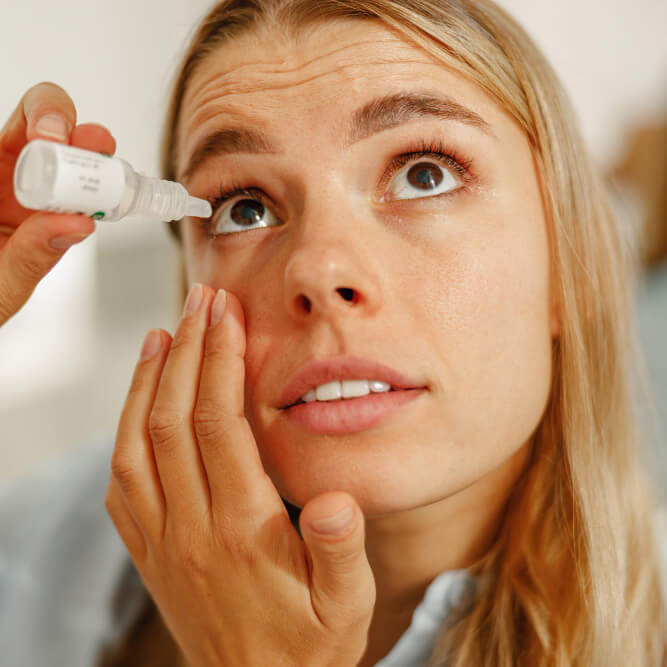Dry, burning, or irritated eyes can make even simple tasks such as reading, driving, or working on a screen feel uncomfortable. What makes it even more difficult is that dry eyes often don’t have just one cause. It might be related to blocked oil glands, tear film instability, inflammation, hormone shifts, or even nerve sensitivity. When these root issues aren’t addressed, the problems keep coming back, no matter how many eye drops you use. That’s where integrative dry eye therapy can help.
The treatment is especially suited for patients who’ve tried eye drops and medications with little success and are looking for a solution that more effectively addresses the root cause. At JIYA, in Raleigh, Dr. Jindal offers integrative dry eye therapy using advanced diagnostics, in-office procedures, and personalized lifestyle support to help restore lasting eye comfort.

What Is Integrative Dry Eye Therapy?
Integrative dry eye therapy is a personalized approach to treating dry eye diseases. This method looks at all factors that may be contributing to dryness, such as blocked oil glands, poor tear quality, inflammation, hormone changes, screen exposure, and even diet or environment.
At JIYA, Dr. Jindal uses advanced diagnostic tools to identify what’s causing your dryness, whether it’s inflammation, blocked glands, hormone changes, or screen-related stress. Treatment is then tailored to your needs and may include gentle in-office procedures, nutritional support, eye care habits, and lifestyle changes. The goal is to restore natural moisture and comfort to your eyes, with long-lasting results.
Advantages of Taking Integrative Dry Therapy
Integrative dry therapy offers a more complete and lasting approach to managing dry eye disease, with several key benefits that set it apart from conventional treatments:
- Addresses the root cause: This approach focuses on resolving the underlying issues that lead to dry eyes, such as Meibomian Gland Dysfunction, inflammation, or tear film instability.
- Provides personalized treatment plans: Each plan considers your lifestyle habits, health history, and individual eye needs.
- Reduces dependency on drops: By improving the function of the tear system, many patients require fewer eye drops over time.
- Supports overall eye health: This approach not only relieves discomfort but also helps protect the surface of the eye and maintain clearer, more stable vision.
- Minimally invasive: Most therapies are non-surgical and gentle, with little to no downtime.
Ideal Candidates for Integrative Dry Therapy
Many individuals experience dry, irritated eyes that don’t improve with standard treatments such as artificial tears or prescription drops. Integrative dry eye therapy is designed for those seeking a more personalized and comprehensive approach, addressing both the underlying causes and lifestyle factors that contribute to chronic symptoms.
You might be a good candidate for integrative dry therapy if any of the following apply:
- Conventional treatments haven’t provided relief: If you’ve already tried lubricating drops, medications, or in-office procedures with limited success, integrative therapy may help uncover and address factors such as diet, hormonal changes, or inflammation.
- You have Meibomian Gland Dysfunction (MGD): MGD is one of the most common contributors to evaporative dry eye. Patients with blocked or under-functioning oil glands often benefit from therapies that support gland health, improve tear film stability, and reduce surface inflammation.
- You spend long hours on screens: If your eyes often feel dry, strained, or fatigued after using a computer or phone for extended periods, it may be because of reduced blinking during screen time. This can cause your eyes to lose moisture more quickly. Integrative therapy offers practical solutions such as guided blinking techniques, visual breaks, and workspace adjustments to help relieve digital eye strain and improve overall eye comfort.
- You’re experiencing hormonal changes: Perimenopausal and menopausal women frequently experience dry eye due to hormonal fluctuations. Integrative therapy may incorporate dietary adjustments, supplements, or topical treatments that support tear production and keep the front of the eyes properly moisturized and protected.
- You’re looking for a long-term solution: If you’re seeking a treatment plan that goes beyond managing symptoms, integrative therapy focuses on long-term improvement.

About the Procedure
At JIYA, Dr. Jindal focuses on identifying the underlying factors contributing to your discomfort and building a personalized care plan. From your first visit, he takes the time to understand how dry eye is affecting your daily life, whether it’s screen fatigue, blurry vision, irritation, or sensitivity.
He performs a thorough assessment using non-invasive tools to evaluate your tear quality, gland function, and eye surface health. This allows him to diagnose the cause accurately, rather than just treating the symptoms.
Depending on your needs, your treatment may involve:
- In-office procedures to unblock oil glands, improve tear film stability, or place small tear duct plugs that can help retain moisture.
- Targeted therapies, such as healing eye drops or biologic membranes, reduce inflammation and repair the eye’s surface when needed.
- Lifestyle and nutritional guidance tailored to support long-term comfort, especially if hormones, diet, or digital habits are contributing to your symptoms.
Throughout the process, Dr. Jindal works with you to ensure every part of your care feels manageable, effective, and genuinely supportive.
Recovery and Aftercare: Integrative Dry Therapy
Recovery after integrative dry eye therapy is smooth, with little to no downtime. As the treatments are non-invasive or minimally invasive, you can typically return to your daily activities the same day, especially if you’ve undergone in-office procedures.
That said, Dr. Jindal will provide aftercare instructions based on the specific treatments you’ve received. Some patients may experience slight eye irritation, sensitivity to light, or temporary blurred vision after procedures. These effects typically resolve within a few hours to a day.
Here are some aftercare tips:
- Use prescribed eye drops or ointments as instructed to support healing and reduce inflammation.
- Avoid rubbing your eyes, especially after procedures, as this can interfere with healing.
- Stay hydrated and maintain a balanced diet; nutritional support plays a role in tear production and eye surface health.
- Limit your screen time.
- Practice eyelid hygiene, especially if you have Meibomian Gland Dysfunction.
Dr. Jindal will schedule a follow-up visit to check on your progress and make any necessary adjustments to your care plan. If required, additional treatments or nutritional support may be recommended to maintain long-term results. You’ll also receive guidance on lifestyle habits that can help protect your eyes and minimize the chances of future dryness or irritation.
Results After Integrative Dry Eye Therapy
The results of integrative dry eye therapy are often gradual but meaningful. Rather than offering short-term relief, this approach is designed to restore balance, improve tear quality, and support healthier eyes over time.
Many individuals begin to notice improvements in eye comfort, moisture, and clarity within the first few days to weeks, depending on the condition and type of therapy. Relief continues to build as inflammation is reduced, oil gland function improves, and personalized care strategies begin to take effect.
Here’s what you can expect after treatment:
- Less dryness and irritation during daily activities.
- Improved comfort during screen use or reading.
- Fewer symptoms like burning, redness, or blurred vision.
- Better tear retention and long-lasting hydration.
Cost of Integrative Dry Eye Therapy
The cost of integrative dry therapy varies depending on the type and combination of treatments recommended. As Dr. Jindal creates a fully customized care plan for each patient, pricing is based on your specific needs, the symptoms, and whether any in-office procedures are included.
During your consultation, you will get a detailed breakdown of your treatment plan, including all associated costs. Financing options may be available for qualifying treatments, and our team is happy to answer any questions you may have.
Get Relief from Dry Eyes Today
Get personalized care that targets the root cause of your dry eye. Book your consultation by calling (919) 929-6006 or filling out the online form.
Frequently Asked Questions
What is the innovative treatment for dry eyes?
Intense Pulsed Light (IPL) therapy is one of the most innovative treatments for dry eyes today. Originally used in dermatology, it has been adapted to treat Meibomian Gland Dysfunction (MGD), a leading cause of dry eye. It uses gentle pulses of light around the eyelids to reduce inflammation, improve gland function, and restore healthier tear production.
What is the most effective treatment for dry eyes?
The most effective treatment depends on the underlying cause of your dry eye symptoms. For many, a combination of meibomian gland expression, punctal plugs, and nutritional support works best.
How much does IPL for dry eyes cost?
The cost of IPL for dry eyes typically varies depending on your location, the number of sessions needed, and whether it’s combined with other treatments. Most patients require a series of 3–4 sessions for optimal results.
What is the newest treatment for dry eye disease?
Among the newest advancements in dry eye treatment are light-based therapies (like IPL) and biologic eye drops derived from serum or amniotic fluid. These treatments focus not just on relieving symptoms but on healing the eye’s surface and restoring natural tear function.